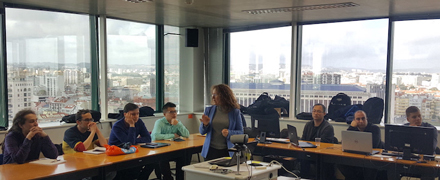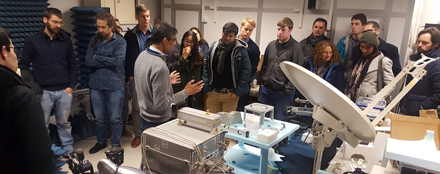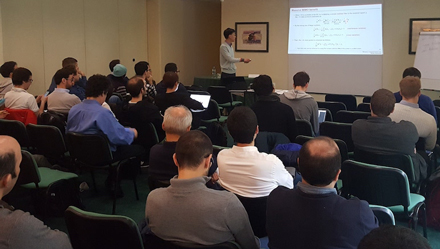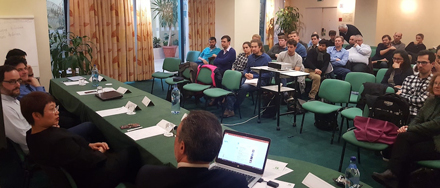|
The Winter School was hosted by IT and was organized by The IEEE VTS Portugal Chapter together with COST CA 15104 “Inclusive Radio Communication Networks for 5G and Beyond”.
In the first day, apart from an introduction to 5G and its standardization, the participants have discussed the most promising scenarios for 5G and beyond. The 4.5 days training period has also addressed recent advances in propagation and channel models for the millimeter-wave (mmW) frequencies, signal and multi-antenna processing, making use of information theoretic concepts and with emphasis on massive number of antennas and hybrid beamforming schemes.
Not only the design of the necessary modulation and coding schemes has been discussed but also spectrum management strategies and interference reduction techniques to achieve implementable Massive Antenna Array Systems (MAAS) technologies at mmW frequencies, with the ultimate goal of providing mobile communication systems that approach 1 Tbit/s data rate on a per link basis. Business aspects, the cost/revenue trade-off, public policies for spectrum sharing, entrepreneurship and IPR protection have also been central parts of the training.
The opportunities created by the raising interest in the millimeter wavebands use has been the motto of the discussions and also for the very live discussion during the Workshop on Massive Array Antenna Systems for Millimeter Wavebands B5G Networks, held at the Holiday Inn Lisboa Hotel on 8 March. Opened to the wide research and industry community, this Workshop that was part of the Winter School program culminated in a Panel on Trends on Beyond 5G Research with brilliant contributions from the participants. More than 60 people attended the workshop.
Students had the opportunity to share their own recent research findings in a poster session that allowed for sharing ideas with their colleagues and tutors. Academic vision has been complemented by industry/services experience and the “hands-on” part of the training (prototyping with OpenAirInterface), culminating with a final work on how to create their own business, as entrepreneurs.
The technical part also included a visit to the Antennas and Propagation Laboratory from Instituto de Telecomunicações, while the social part included a very enjoyable visit to the Faraday Museum from Instituto Superior Técnico and a dinner in the Museu da Cerveja, downtown Lisbon.

Ana Garcia Armada gave the overview on 5G / B5G: scenarios and standardization efforts, including the planned schedule.

Students visited the Antennas and Propagation Lab, where Carlos Fernandes introduced the IT research on mmW.

Students were very enthusiastic about the entrepreneurship part of the School.

Two VTS Distinguished Lecturers were invited. Multi-antennas techniques for 5G was Inkyu Lee’s theme, while Sumei Sun discussed Distributed-Antenna Systems and energy efficiency.

Jon Peha addressed business and policy issues, as well as the challenges posed by 5G, with great enthusiasm.

Live discussions were the main characteristic of the B5G panel from the Workshop on Thursday. Luís Correia proved an excellent moderator for panelists Sumei Sun, Christos Massouros, Jon Peha and Inkyu Lee.
All photos are provided courtesy of Rooderson Andrade. |